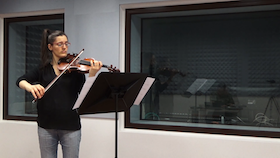AUDIO
-
LORENZO BOSICH
Adventus Hominis (2022)
Adventus Hominis is an electroacoustic composition focused on the advent of Man and his relationship with the perception of Time. The composition investigates the temporal scanning of the human being through three glimpses into three distinct eras: prehistory, the industrial revolution and western civilization between the 20th and 21st centuries. The first presents elements of a life characterized by tension and uncertainty due to the need to procure nourishment, the more visceral work with the land and the impetus of clashes between tribes. The second focuses on a hypothetical day's work of a worker in a factory where man himself becomes a machine. Finally, the last part sees the clock as the protagonist, "director" of modern man in an increasingly frenetic and technological society, which however does not cancel the primordial aspects of prehistoric man and which are evoked by a recurring element during the whole composition.
-
DAVIDE CASTELLANO & SNEZANA ACIMOVIC
Chasing Moments, violino/live‑electronics (2016)
During most of the piece it is accorded to violinist a certain degree of dynamic, rhythmic and agogic freedom; certain sections, instead, are accurately noted and they are presented different times, identical or slightly varied. The electronics performer manipulates the live-recorded sound of the violin, transforming and reproducing it by means of delays, FM modulation and “freeze-effect” combined with transposers. The title is referred to the action of the electronics performer, who must apply the “freeze-effect” live to the violin sound being careful in choosing the right moment to be “photographed” and maintained during the piece. The spatialisation separates 3 tracks of “freeze-effect” from the other treatments (which are instead reproduced in a zone near to the player) with the intention of “cheating” the listener in some spots, where it is impossible to distinguish the actual sound of the violin from the electronic effect, also because the player often uses extend emissions.
-
MARCO PARLANTE
A.I.A. - Artificial Intelligent Audio (2015)
Algorithmic composition generated by the computer
What does it mean to improvise for a musician? And having a jam? Composing an original song? Situations that can be achieved by studying, learning, creativity, taste. These processes and experiences can be analyzed and then translated into numbers and algorithms. The taste could be seen as being able to recognize a musical combination working better than one that sounds too obvious, and this choice could be given from the experience and from the culutral baggage.
Then the cultural baggage becomes a set of data and numbers, a virtual memroy, while the taste is transformed into a series of algorithms that decide how to use the best of their knowlenge.
A reversal of the protagonist: analyzing the music and human behavior, translating them into informatic laguage, applying to software that then bring them to music. Music from computer, not from man anymore. Different music at every play, unpredictable and able to surprise even its creator.
“Artificial Intelligent Audio” is a self-generative composition based on algorithms inspired by human behaviors, that has an own virtual enthusiasm wich affects the choices, able to improvise, to make decisions on the development of the song, to discard unwanted solutions and learn from itself.
-
IVAN PENOV
Tentativi
Tentativi is a piece deriving from different experiments in using controlled feedback methods. In the control part it was intentionally left an “error” (glitch) which added fragility. This became a decisive element fro the creative process. All the materials come from an improvisation of mine using the mouth resonation together with a feedback path interrupted by a granular synthesis process. This allowed blocking the feedback accumulation and led to the generation of unpredictable textures. Everything is in a fact a kind of technical metafore of poetic idea of the piece, that is “trying emitting the voice (a note, a melody…) without a positive output and coming instead to completely different and extraneous reality.
"Tentativi” has been selected at the 35th “Concours Internationaux de Musique et d’Art Sonore Electroacoustiques de Bourges”
-
GIACOMO BISARO
Ekphonosis (2012)
Title is a mix between two ancient greek words: ekpyrosis and phonos (sound).
The first term, in Stoic philosophy means “conversion to fire”, and is the periodic destruction (and then rebir- th) of the cosmos: fire destroys everything, but also releases the energy to generate a new world.
The basic idea of this work is to take an object, in this case a common empty coffee can, to give it life by allowing it to emit sound (surrounding it with an elastic rubber, to be picked as a string), and then to explore every acoustic possibility I can get from this instrument, till the ones that can cause the death (breaking) of it.
Then, the tile: Ekphonosis: sounding possibility can give new life to the object, but this is going to waste and destroy it.
-
ALESSANDRO FOGAR
Boreas (2010)
Boreas is mainly inspired, by the musical point of view, to some early Bruno Maderna’s techniques (used in compositions like Continuo and Notturno); the piece is in fact an homage to Maderna's Serenata per un satellite. The performer with his movements activates remote soundscapes, and reverberations: the sound of waveless sea, the world as a far remembrance, the wind that lashes and lightly ripples the sea surface, generating an infinity of small waves that intersecate and interfere each other, the sun rays that, reflecting on the sea surface, create infinite reflections.
Boreas is usually presented as a real-time performance, with a performer controlling and influencing, by means of a graphic tablet and a MIDI controller, interactive and auto-referential composition processes, applying various techniques (granular synthesis, transposition, filtering etc.) on fragments of concrete sound material analysed in real-time.



